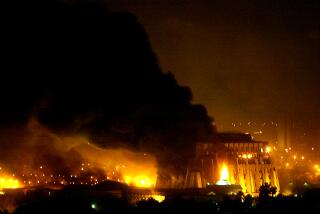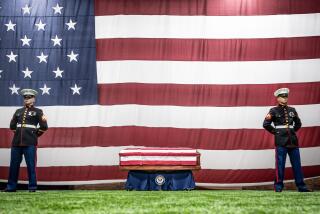Making Bombers in Iraq
- Share via
RASHIDIYA, Iraq — Namir Awaad was a suicide bomber made in Iraq.
There is no evidence that he belonged to Al Qaeda or trained in a terrorist camp. He spent 23 apparently uneventful years on the planet until the chilly morning of Dec. 9.
That’s when the slender, bearded loner strode up to a Bradley fighting vehicle guarding a U.S. Army base here and detonated a backpack bomb, blowing himself apart and injuring a soldier.
Because a quirk of physics left his face intact, Awaad became one of the few suicide bombers in Iraq to be definitively identified. The case helped expose a home-grown network suspected in a string of suicide bombings that have killed more than 25 people in this volatile zone northeast of Baghdad. Authorities have detained several Iraqis suspected of being accomplices and believe that three car bombers were Iraqis.
The developments here -- and signs elsewhere of Iraqis plotting or training for suicide attacks -- throw into question the widely held view that Iraq’s suicide bombers are exclusively foreign jihadis. U.S. and Iraqi officials repeatedly have said that Iraqis are unlikely to engage in such missions because they do not have a history of violent religious extremism.
The prospect of Iraqi suicide bombers represents a widening of an already brutal offensive.
The cases in this area suggest that the jihadist culture of suicide bombing has taken root in the ravaged landscape of postwar Iraq. Less than a year after the fall of Saddam Hussein, militant recruiters -- be they foreigners or Iraqis -- are grooming disaffected young Iraqis to become human missiles targeting occupation forces and Iraqis seen as collaborators, officials say.
“In the beginning, we were pretty sure that it could not be Iraqis,” said Lt. Susan M. Greig of the California National Guard, who oversees law enforcement in Diyala province from her headquarters in nearby Baqubah. But “after the war, you have a lot of farmers, a lot of unemployed people.... They don’t understand why we are here. All they can see is that their life has gotten worse. So what we are seeing is that those are a lot of the people being used as foot soldiers.”
It seems clear that foreign suicide attackers operate in Iraq. But the more complex picture that is emerging indicates that various factions have embraced the most devastating weapon in the insurgency’s arsenal.
Extremism festers in places like the lush farmland where Awaad came of age among orange trees, date palms and walled tribal compounds along the Tigris, U.S. and Iraqi investigators say. Awaad was a morose middle-school dropout who became consumed by Islam: a trajectory typical of holy warriors throughout the Muslim world.
This insular town also was home to two attackers who pulled off synchronized suicide car bombings in November at police stations in Baqubah and the nearby town of Khan Bani Saad, investigators say. The insurgency here unites die-hard loyalists of Hussein’s secular dictatorship with adherents of the ultraconservative Wahhabi sect of Sunni Islam.
“These are people who would never get together,” said Lt. Col. Michael T. Mahoney, commanding officer here with the Army’s 4th Infantry Division. But “none of them wants the Americans here. So they join forces temporarily.”
In the background is the elusive specter of Al Qaeda-style groups.
In recent weeks, top coalition officials have accused Abu Musab Zarqawi, a Jordanian affiliated with Al Qaeda, of masterminding the terrorist campaign in Iraq. U.S. forces are hunting for Zarqawi in Iraq and say they killed his top bomb maker in a firefight west of Baghdad last week.
The car bombers in the Baqubah area “were Iraqis working with Al Qaeda,” an Iraqi police chief said. “An Iraqi is not ready to do this unless he is with those linked to Al Qaeda.”
In recent weeks, security forces have seized video CDs that feature Muslim extremists conducting clandestine ideological and training sessions in which recruits wear white cloaks designated for suicide bombers, U.S. and Iraqi officials said. Investigators believe the videotaped training took place in Iraq and Syria.
Despite the widespread focus on an external threat, it is difficult to identify a bombing in which foreign fighters have been arrested or their participation as bombers has been confirmed.
“Overall, the facts say the majority of the folks we are fighting here are Iraqis,” said Lt. Col. Ken Devan, intelligence officer of the Army’s 1st Armored Division in Baghdad, which has arrested fewer than 30 foreign fighters. “Even if we said every car bomber is a foreigner, it’s not that many.... Are there Iraqis who are willing to suicide themselves? There probably are. Do we know conclusively who’s responsible? The only conclusive way we are going to be able to tell is if we find an ID card on them, and we just don’t see that after a suicide bombing.”
After one of five car bombers initially survived a coordinated strike on the first day of Ramadan last fall in Baghdad, he told a doctor that he was Yemeni. But investigators could not confirm the wounded man’s nationality before he died, said a senior military official who declined to be identified.
“He was a Yemeni only because he said he was Yemeni,” a senior military official said.
The apparent cell detected in this town is not the first sign that Iraqis may be lining up for so-called martyrdom operations. Iraqi Kurds associated with the Ansar al Islam group have trained as suicide attackers. And in November, soldiers of the Army’s 3rd Armored Cavalry in western Iraq captured three would-be suicide bombers with an explosives vest ready for action. They were Iraqis, said Col. David Teeples, the commanding officer.
About the same time, a wave of attacks hit the region around Baqubah. Two car bombers hit the police stations in Baqubah and Khan Bani Saad during morning roll call Nov. 22, killing more than 17 people. Two weeks later, Awaad struck at the gate of Lt. Col. Mahoney’s base here. Six days after that, a car bomb outside a police station killed eight in the town of Husseiniya, on the road to Baghdad.
Iraqis are suspected in all three car bombings.
The almost simultaneous attacks in Baqubah and Khan Bani Saad were related, investigators concluded. Officials established that the two drivers were young Iraqis from the Rashidiya area, U.S. and Iraqi investigators said. The two young attackers were seen together at a gas station with the vehicles used in the attacks before the dual strike.
“People saw them kissing and saying goodbye,” Greig said. “We can trace them back to where we know they knew each other.”
Holy warriors from abroad and from insurgent strongholds such as the city of Fallouja are said to be enlisting young Iraqis for suicide bombings as well as guerrilla-style attacks, military intelligence officers say.
Commanders suspect Awaad fell under the spell of recruiters in Rashidiya. He made his strike at the entrance of the U.S. base, which occupies a former hospital complex run by the Iraqi military.
Awaad’s backpack bomb was wired to his torso and legs under a traditional dishdasha robe. He wrapped his head in white bandages, apparently posing as one of the injured Iraqis who show up at the gate seeking treatment from U.S. troops inside. “He walked up to the vehicle and they thought it was somebody who was hurt,” Mahoney said. A crewman in the Bradley “had just gotten on top of the turret to go down and see what was wrong with this guy when he blew himself up.”
The soldier suffered only minor injuries. Awaad may have been an amateur or ill-prepared. His pack contained no ball bearings or other potential shrapnel. After the explosion, U.S. troops found the largely intact front of Awaad’s head next to the Bradley fighting vehicle. They distributed photos of the face in the community.
The bomber’s father came forward. He told U.S. officers that his son had become obsessed with Islam upon his return last year from three years of military service.
Awaad refused to work in the fields, his family said. He took refuge at a Wahhabi mosque, where he served as a prayer chanter, or muezzin. He spent hours reading his red-bound Koran in the two-story stucco house his family shared with his uncle’s family.
Awaad argued often with his father, a farmer of modest means who had endured 10 years in an Iranian prisoner-of-war camp in the 1980s. Their final blowup came in December when the father refused to let Awaad marry unless he got a job.
“His father did not have money to offer him for his marriage,” said Fahad Abad Salima, a neighborhood sheik. “He became angry with his father. He had so many problems. He could not complete his marriage. His life was so complicated by these things.”
Awaad dropped out of sight for four days, reappearing on the morning of his attack. It is likely that accomplices helped him rig the bomb and manipulated him psychologically, authorities said.
“They tricked him into thinking he was in a whole ring of guys who were going to do this,” Mahoney said. “At the time of the mission, he stepped forward, and they stepped back.”
Commanders suspect that some young men in the area who have gone missing may have died in suicide attacks. In the aftermath of the wave of bombings, military officials here have investigated several “martyrs” funerals, services without bodies, but have not conclusively linked them to specific attacks.
The reaction in Awaad’s village to his “martyrdom” differs markedly from the glorification prevalent in the Palestinian territories, where bombers are celebrated in posters plastering village walls.
Awaad lived on a narrow road that winds through edgy hamlets where U.S. military convoys venture with caution. Family and neighbors do not openly praise Awaad’s exploits.
Salima, the tribal leader, is intent on downplaying the incident. The gravelly voiced sheik held court recently in the Awaad family living room. The bomber’s male relatives knelt on the carpet and nodded as the sheik, hoisting a teacup ceremoniously, said he knew nothing about any unexplained disappearances of young men.
As for Awaad, the sheik and others insisted that he was not a terrorist pawn. Even though suicide bombers usually get indoctrination and help preparing their devices, Salima said he was convinced that Awaad had no accomplices.
He theorized that perhaps the young man had picked up explosives expertise in the army, where he served as a cook and, according to villagers, spent a lot of time chopping onions.
“He had no friends,” Salima said. “He could not have been influenced by any friends. You can see our young men here sitting together, talking together. He was not that kind. He wanted to die.”
There are no terrorists in this village, the sheik declared -- Awaad was just a solitary, tormented soul who decided, on his own, to end it all.
More to Read
Sign up for Essential California
The most important California stories and recommendations in your inbox every morning.
You may occasionally receive promotional content from the Los Angeles Times.










